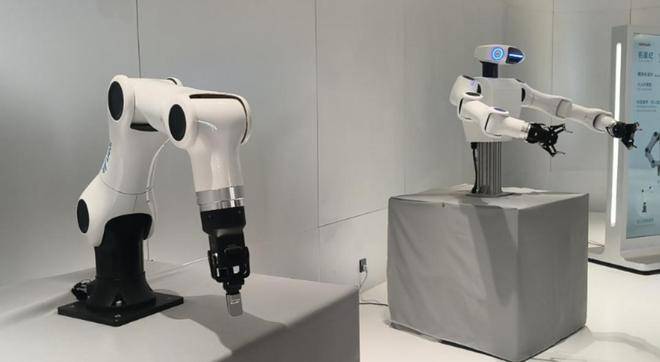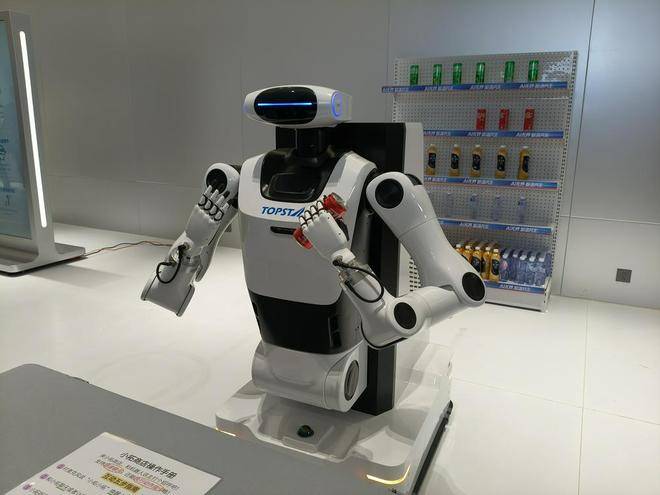Caixin reported on September 13 (Reporter: Lu Tingting) that the embodied intelligent robot industry is gaining momentum, with the humanoid robot sector, as an important branch, experiencing a continuous rise in investment enthusiasm. Ecosystem companies are closely monitoring high-potential opportunities in vertical fields to accelerate new product launches.
On September 12, Tuosda (300607.SZ), known as the ‘first robot stock in Guangdong,’ held a global open day event in Dongguan, showcasing the company’s key robotic components testing, product matrix, and the latest achievements in embodied intelligent development for industrial scenarios. At the event, the humanoid robot ‘Xiao Tuo,’ designed with a four-wheel steering system and capable of 360-degree omnidirectional movement, attracted considerable attention. This is Tuosda’s first publicly released humanoid robot, equipped with the Zhipu AI large model, which possesses the ability to perform complex task reasoning using a thinking chain.
Tuosda’s wheeled humanoid robot. Image source: Caixin reporter/photograph
‘This is the first humanoid robot applied in the injection molding industry,’ Tuosda representatives explained. ‘Xiao Tuo’ has completed multiple rounds of verification in the injection molding workshop. By integrating a 3D camera and an AI visual inspection system, it can identify the yield of injection-molded parts in real time and autonomously complete processes such as loading trays, achieving full-process automation from inspection to operation.
It is reported that Tuosda began its layout in embodied intelligence in 2023, continuously making progress in high-precision component manufacturing, core process advancement, and robot integration. From the production chain perspective, ‘Xiao Tuo’ showcases several of Tuosda’s R&D technologies.
According to Caixin reporters, ‘Xiao Tuo’s’ core components are processed by Tuosda’s holding subsidiary, Evermi, using the DMU400 five-axis CNC machine. This machine relies on self-developed spindle and GTRT gear-driven cradle turntable technology, achieving high rigidity cutting with precision exceeding one-third the diameter of a human hair, providing the robot with reliable ‘reinforced bones.’
Regarding servo control technology, Tuosda’s chief servo technology expert Wang Zhicheng stated that mechanical end jitter suppression control technology has been successfully applied to ‘Xiao Tuo,’ providing crucial technical support for the large-scale deployment of humanoid robots.
In addition to the wheeled humanoid robot ‘Xiao Tuo,’ Tuosda also released humanoid dual-arm robots and humanoid robotic arms at this event.

Tuosda products. Image source: Caixin reporter/photograph
AI investment expert Xia Shuang stated in an interview with Caixin reporters that the development speed of the humanoid robot industry far exceeds that of emerging industries such as smartphones and new energy vehicles. This is attributed to multiple factors, including the high performance ceiling opened by breakthroughs in AI technology, the presence of numerous startups exploring various technical routes, the resolution of hardware bottlenecks in robots, ample industrial resources and funding support, sufficient market space and demand, and the availability of successful experiences from previous emerging industry developments.
Xia further stated that although we feel that the performance breakthroughs of humanoid robots have been rapid in the past two years, with humanoid robots transitioning from unstable walking to now being able to dance, punch, and fold unfamiliar clothes flexibly, they are expected to maintain this development speed in the coming years, continuously bringing new surprises.
Currently, humanoid robots are accelerating their integration into industrial sites. Not only Tuosda, but Estun (002747.SZ) also stated at a performance briefing that its second-generation humanoid robot Codroid02 is currently undergoing small-scale verification in industrial scenarios.
Moreover, Midea Group (000333.SZ) has deployed its self-developed industrial humanoid robot ‘Mei Luo’ at its washing machine factory in Jingzhou. Recent field visits by Caixin reporters found that ‘Mei Luo’ stabilizes the transportation of a 9 kg washing machine tub to the 3D intelligent inspection station through dual-arm coordination with a single arm handling a 3 kg load, and after delivering the item, it turns around to execute fire inspection tasks.
Midea Group told Caixin reporters that the foundation for this scheduling is a self-developed six-dimensional force control sensor in the wrist that adjusts grip strength and dual-arm posture in real time to achieve dynamic balance during transportation.
Industry insiders are optimistic about the scenario-based deployment of humanoid robots. Morgan Stanley predicts that by 2035, there will be approximately 13 million humanoid robots of various types globally, primarily used in industrial and commercial fields.
‘Although almost all humanoid robot companies are currently focusing on industrial scenarios, even if each company develops smoothly, they will not be able to meet the entire industrial demand because the market space for humanoid robots in industrial scenarios is vast and is a complete ‘blue ocean,’ allowing many humanoid robot companies to develop well together,’ Xia believes. Currently, the application of humanoid robots in industrial scenarios is mostly concentrated on handling tasks, while slightly more complex generalized assembly tasks have not yet been overcome, indicating that the market is waiting for technological maturity. Many large manufacturing companies have laid out humanoid robots, and once the technology matures, their investment in this technology will also be relatively quick, providing many market opportunities for technologically leading startups.
Regarding future development directions, Tuosda Chairman Wu Fengli stated on site that the company will continue to consolidate and expand its main business, focusing on high-end intelligent equipment and promoting the landing of artificial intelligence technology in manufacturing scenarios. Tuosda’s humanoid robots will deeply integrate processes and scenarios to accurately solve practical application problems, ultimately constructing a sustainable business closed loop.返回搜狐,查看更多

